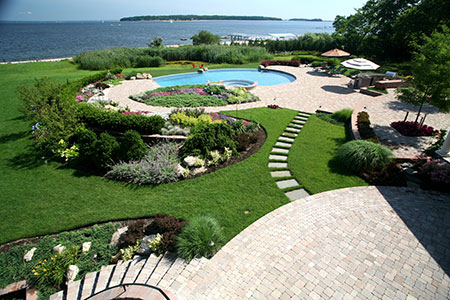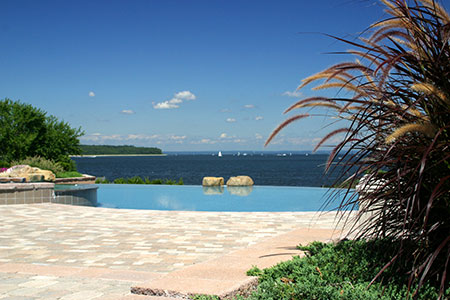Awarded
Best in State by NYSNLA
&
‘Gold Award’ in 2007 by LINLA
for best Rear Yard
Entertainment Area

See this Award-winning project featured in the
March-April 2007 issue of HOUSE Magazine
Spring GARDENING TIPS
March: Best time to do heavy pruning
of trees and shrubs.
Late March: Time to plant pansies. Also good time
for first lawn fertilization of the season.
Early April: Time to prune roses.
April: Ideal time to divide and move perennials,
and to remulch beds.
Mother’s Day: Generally, last date for killing
frost. Time to begin planting summer flowers and to turn on irrigation
system.
June 1st: Safe to put cold-sensitive tropical
plants outside. Introduce them only gradually to full sun.
Late June: Time to remove pansies and other cool-weather
annuals and replace with summer flowers.
Spring Bulbs: Save or Remove?
Spring-flowering bulbs are loosely categorized into
two groups in our climate: those that come back reliably every
year, and those that don’t.
Daffodils, Narcissus, and most hardy woodland bulbs
usually return year after year, as long as their leaves are allowed
to turn brown after flowering before being cleaned up.
Tulips and Hyacinths, however, don’t stay green long
enough to consistently produce flowers for the following season.
Two or three seasons of brilliance is all you can expect, so it’s
a good idea to remove them, bulb and all, right after the second
year of flowering, while you can still find them. You can then
plant new ones in the fall.
Hydrangeas To Prune or Not
To Prune
Whether or not to prune your Hydrangeas — and how
to prune them — is one of the most common questions our service
department receives. We'll try to simplify the answer for you below.
Old wood or New wood?
Hydrangeas can be grouped into two categories—those
that produce flowers from old wood (branches that form the previous
season), and those that will flower from new wood (branches that
form the same year). Easy, right? Not so easy if you’re not a horticulturist.
So we’ll simplify things a little. Fortunately, nearly all of the
hydrangeas that produce white or whitish flowers fall into the
new wood category, and those that are pink-to-red or purple-to-blue
(depending on how acidic or lime-based your soil is) flower on
old wood. Not to confuse the issue, but the hot new variety on
the market, ‘Endless Summer’, blooms on both old and new wood
and comes in both white and pink. We’ll lean towards the ‘New wood’ category
on that one.
New Wood (white flowers)
You can cut them down to the ground each spring and
they’ll give you great flowers the same year. If they happen to
grow like a tree, then cutting them back hard without losing their
tree-like characteristics will work just fine.
Old Wood (pink-red to purple-blue flowers)
Thin them out in early spring by removing the obviously
dead stalks. You can reduce their overall height if desired by
cutting off the top 12” or so of the remaining stalks, making sure
some live buds remain along the sides of the stalks. Note: after
a severe winter, all buds might be killed, despite your best efforts.
In this case, you won’t see any flowers at all that growing season.
Our 50th Year! 1957-2007
We’ve come a long way since 1957 when Ron Schlick,
recently graduated from the Farmingdale Ag school (now Farmingdale
State) founded Schlick Landscaping. Since then, the Schlick Design
team has garnered over 60 national, state and Long Island awards
for innovation and excellence in landscape design. Our core business
has changed over the years as well, from the installation of simple
patios and plantings typical of the ’60’s, to what it is today—the
design and development of everything outside the four walls of
the home. Today, our team of professionals is as likely to attend
village permit meetings, coordinate pool and pool house installations,
or oversee the layout and grading for a driveway or masonry terrace,
as we are to plant trees and shrubs
In 1986, Gary Blum joined Ron as a full partner.
Gary, who was literally raised in the industry, gained extensive
experience working for two major firms before joining Ron. Gary
holds degrees in Ornamental Horticulture, Environmental Science
and Landscape Architecture.
Ron’s son Peter came on board as a permanent member
in 1990, eventually assuming Ron’s full partnership. Peter, who
also was raised in the industry, has a Master’s degree in Horticulture,
and extensive hands-on experience in both landscape construction
and residential construction management. Schlick Landscaping became
Schlick Design Group in 2001, a change in name which more fully
reflects the core of our business today—the design and construction
of innovative and functional outdoor living spaces—truly ‘Landscapes
for Living.’
SCHLICK Design Group Takes
Two Gold Awards
At their 2007 Landscape Awards Program, the Long
Island Nursery and Landscape Association awarded SCHLICK
Design Group the ‘Gold Award’ in the Active Use
category for the best outdoor home entertainment area,
and the ‘Gold Award’ in the Commercial category for
the St. Paraskevi Church project in Greenlawn. The entire Schlick
Design Team contributed to this success.


2007 Residential Award Winner
2007
Our 50th Year
|



![]() Home | About
Us | Services |Our
Staff | Links | Contact
Us
Home | About
Us | Services |Our
Staff | Links | Contact
Us 

